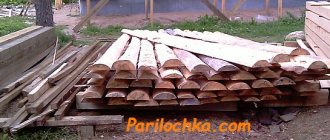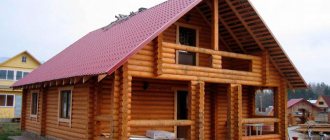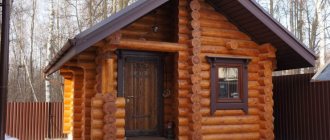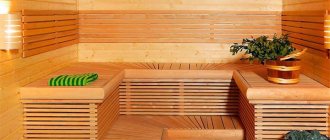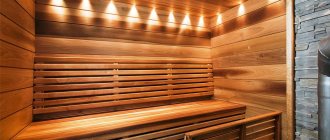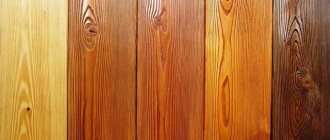The building materials market is overflowing with various types of raw materials for bathhouse finishing. But from time immemorial, wood remains the true queen. It has a unique natural beauty and fills the room with a special aroma.
But before you start purchasing material, it is important to know that wood is not a simple cladding, but a real natural healer; it knows all the secrets of the human body. Therefore, it is so important to competently choose the type of wood for the interior lining of different rooms of the bathhouse.
What functions should the finishing perform?
When choosing interior decoration for a bathhouse, you need to take into account several important points. The first question is whether additional finishing is needed in principle. If the bathhouse is built from large diameter logs, you can leave everything unchanged.
For buildings made of other materials, you will need clapboard or board. It will help create a special bath flavor inside the premises and provide high-quality insulation. Plus, the lining has different profiles and can be mounted vertically and horizontally, in the form of masonry or herringbone.
You can also use a block house or imitation log, and even an unedged board, which will give the interior of the bathhouse a special zest and unique natural flavor. To make the right choice, you need to familiarize yourself with the requirements for interior decoration in a bathhouse.
In addition to decorative ones, wall cladding has practical functions. It accumulates and retains heat, which allows you to spend a minimum amount of energy resources.
At the same time, the surface of the skin remains pleasant to the touch and does not burn.
To effectively perform its functions, the cladding material must have the following characteristics:
Be non-flammable. To give this quality to natural wood, it is treated with special compounds.
Absorb and retain heat without getting hot.
Have high moisture resistance and dry quickly.
Have a natural and environmentally friendly composition, do not emit harmful substances and unpleasant odors.
Stainless steel protective screens
Such heat-resistant panels for finishing walls near the stove are used very widely. Due to the fact that the screen consists of several layers, it protects walls very effectively. The design of such panels is a stainless steel shell, inside of which there is a fire-resistant material. The combination of a heat-reflecting outer layer and a protective inner layer allows you to reduce the distance to the protected surface from the heat source to 5 centimeters.
Characteristics of wood species for a bath
For the interior decoration of the bathhouse, you can use coniferous and deciduous wood. A significant difference between the species is the amount of phytoncides released, which can kill some microorganisms and slow down their growth. Coniferous species contain much more of these substances.
However, choosing wood for a bathhouse based only on the usefulness of the material is wrong.
Other criteria should be taken into account:
- density;
- durability;
- percentage of resin content;
- affordability.
Bath traditions go deep into the past, so our ancestors accumulated enough knowledge about the properties of different types of wood. After studying them, you can choose the most suitable material for finishing the bath.
Larch
This is a beautiful resinous tree with a reddish tint.
The mechanical properties of this species are identical to oak. In addition, larch contains an impressive amount of highly active substances useful to humans.
The main advantages of larch:
- Durability. Even in conditions of high humidity and high temperature, wood is resistant to rot and fungus.
- Over time, wood does not change its color.
- With excellent mechanical properties, it is cheaper than oak.
- The disadvantages include the complexity of wood processing and low thermal insulation properties.
Linden
This is one of the most popular and affordable materials. When heated, linden releases substances that are beneficial to health. In interior decoration, this wood shows its best side.
Even at the highest temperatures, the walls and ceiling will be pleasant to the touch.
Advantages of linden for interior decoration:
- The wood is light and soft. Thanks to these qualities, finishing is time-consuming and easy.
- Linden has low thermal conductivity. Buildings made from this type of wood warm up quickly and require less fuel. In addition, the steam room does not cool down for a long time.
- Well-dried lining does not shrink, and the bathhouse can be heated immediately after finishing is completed.
Linden also has significant disadvantages:
- Low fiber density and resistance to rotting. As a result, insects quickly appear in the material and fungus spreads. For this reason, linden-lined baths must be thoroughly dried after use.
- High price. Linden is more expensive than pine and spruce, but at the same time cheaper than oak, larch and especially cedar. However, given the advantages of this material, the price is quite justified.
Oak
The most durable and moisture-resistant material. But it is used less often in bath decoration due to its high price.
If you want to have a rich environment, oak is the best choice. In order to save money, lining or boards made of this wood are used as additional finishing in order to emphasize some details.
For example, the shelves are lined with linden lining, and the headrest and back are made of oak.
Birch
Wood that has long been valued by bathhouse fans. It is beautiful, fragrant, healing and durable. Birch is soft, tough, and elastic.
It demonstrates anti-inflammatory, bactericidal, antifungal, strengthening, wound-healing, antiviral and antiseptic properties. But birch is afraid of moisture, so it is ideal for finishing the ceiling, walls and floors of recreation rooms.
Aspen
Deciduous species, widely distributed in Europe and Asia.
It has a recognizable light shade and a smooth, pleasant texture.
Choosing aspen for finishing is a good idea due to its advantages:
- does not overheat;
- due to the specific structure of the fibers, it will not cause splinters;
- does not release resin;
- has an acceptable cost.
- The disadvantages include susceptibility to rotting in high humidity and darkening over time.
Cedar
Decorating the bathhouse with cedar looks very beautiful and noble. This wood is easy to process, is highly resistant to temperature changes and moisture, and is not afraid of insects and fungi.
Cedar is rich in healing essential oils, thanks to which a unique aroma will reign in the room.
However, the persistence of the aroma is considered not only among the advantages, but also among the disadvantages of cedar.
- Some owners of cedar steam rooms note with annoyance that the pleasure lasted a little more than six months and soon the smell began to irritate. And the material was very expensive.
Ash
Boards and lining made from this species look very presentable. The color of the wood is dark, the structure is dense. Ash is especially recommended for making shelves. Dense, non-porous wood does not allow dirt to penetrate inside. Ash has a high heat capacity.
At the same time, the surface does not overheat and does not burn the skin. Lying on the wide and warm ash loungers is very comfortable. A solid ash shelf is the best solution for a steam room with a temperature/humidity mode of 60/60.
- The disadvantages of ash include its relatively high cost. It is also worth considering the material’s susceptibility to temperature changes: such lining in a steam room will require careful and regular maintenance.
Abash
The exotic tree is an analogue of the oak familiar to Russians. It has no less impressive properties than its domestic counterpart. This is one of the best materials for finishing a bath.
Abashi wood is lightweight and amazingly durable. The material has no knots and does not emit resin.
The advantages of this type of wood:
- the amazing ability to adapt to the temperature of the human body;
- low thermal conductivity: wood does not overheat even at extreme temperatures;
- does not deform or shrink even with changes in humidity;
- resistant to rotting.
- This material has only one drawback. Since it is exported from African countries, its cost is much higher than the usual local materials. Therefore, such a finish is not affordable for everyone.
Expert opinion
Lovkachev Boris Petrovich
Bath master who knows everything about steaming
It is not recommended to use maple and beech for construction or interior decoration of bathhouses. They have a loose structure and even at low humidity begin to rot.
Minerite slabs
One of the most effective ways of protection. Ninety percent of the slab composition is ordinary gray or white cement, which serves as an excellent heat insulator. The remaining ten percent of the composition is reinforcing fiber and mineral fibrous material. Outwardly, they are not always beautiful and therefore they are often additionally decorated with artificial stone, tiles or painted.
Important: mineralite can easily withstand heating up to 150 degrees, but to more effectively protect the walls, it is better to leave an air gap between the mineralite sheet and the insulated surface. If this is undesirable or impossible, then the mineralite sheet is mounted on a heat-resistant substrate, which increases the effectiveness of protecting the structure.
In addition, the sheets can be deformed from heating and when installing two sheets at once, it is necessary to leave small gaps for temperature deformation.
Selection of materials for different rooms
The microclimate of different rooms in the bathhouse is not the same, so you need to choose the material for the cladding, taking this circumstance into account.
Waiting room
The temperature in the rest room does not rise to critical levels and the humidity in this room is low. Therefore, any type of wood is suitable for finishing the dressing room.
Here you can save money by using low-price material:
Pine . This wood has a beautiful pattern and a pleasant shade, so it can be used to create coziness. The shade of pine wood is light pinkish, and becomes deeper over time. Scandinavian pine is particularly durable, although its cost is much higher than domestic ones.
Spruce . Linings and boards made from this wood undergo heat treatment during production, which gives them moisture resistance and strength. Spruce exudes a subtle, pleasant aroma and does not emit a lot of resin, like pine.
Washing
The washing room is most often located in front of the steam room, so it has a comfortable temperature. But it contains high humidity, so the materials are subject to special requirements regarding moisture resistance.
Often the walls are sheathed with larch - a stable, moisture-resistant material that dries quickly and does not deform.
Steam room
This is the most problematic place in the bathhouse. Because of the high temperature, you shouldn’t use conifers there, and because of the high humidity, deciduous trees will rot there, but if you don’t take too much care of them.
The best materials for a steam room:
Alder
Its cognac aroma and noble shade will delight you with its aesthetics and impeccable operation. Over time, the aroma becomes even more noble, and the shade also pleases with its nobility. But it will be difficult to buy smooth alder cladding, and it will cost a lot.
Linden
It has an excellent aroma, but its white surface forces you to handle it very carefully, not to pollute it, for example, with brooms and various infusions, essential oils - it is very easy to stain it, but it is difficult to wash it. Linden is chosen by connoisseurs of its subtle healing aroma and very careful bath attendants and steamers. Linden is an excellent option for those who like fairly high vaping temperatures, since its surface is not able to heat up.
Aspen
Ideal for the steam room, although it has a slightly bitter aroma. Aspen has long been considered the material that drives away illness and disease, as well as bad thoughts. This is a real healing tree.
Ash
Sometimes the finishing of the bathhouse is made of ash. The material looks expensive and noble, the texture is dense and beautiful.
Larch
An excellent option for finishing a steam room. But processing it is difficult, the structure easily splits. But it contains gum, thanks to which the lining is maximally resistant to humidity and has high thermal insulation parameters for the room.
Cedar
It is distinguished by soft and ductile wood, can be processed with ease, and is extremely beautiful. The high value of cedar is its special smell and amazing effect on the body.
Advice! For additional strength, the wood used for steam rooms and washing rooms can be heat treated. The material prepared in this way is more resistant to a humid environment, resistant to fungal diseases and takes on a chocolate-brown hue.
Facade cladding
Installation of fiber cement boards is carried out in a strictly defined sequence. First of all, clean the surfaces of the walls from debris and adhesion. Then, window sills, pipes, and other protruding elements are dismantled; carry out marking of fastenings.
The critical step is attaching the base for the slabs, which are made in most cases from oxidation-resistant metal alloys. Mineral insulation is placed and fixed on the walls, which performs heat-insulating functions. At the final stage, fire-resistant fiber cement panels are installed.
What is important to know about wood quality
In addition to the type of wood, it is important to consider the quality of the material when purchasing.
Its operational characteristics are determined by the class:
Extra – the highest quality, without knots or defects.
A - also has impeccable qualities, but it can show a texture typical for this breed.
B – small knots and pronounced patterns are possible.
C is the lowest quality grade with noticeable knots and uneven texture.
For finishing steam rooms, it is optimal to use Extra, A-class lining and a mixture of A and B. This is due to the fact that large knots with overheating and constant changes in humidity can lead to deformation of the entire canvas and the formation of traumatic chips and splinters.
Class C lining can only be recommended for dressing rooms, rest rooms and other auxiliary premises.
If the premises are sheathed with edged boards, it is also worth considering the quality of the material. In the steam room and washing room, it is recommended to use extra-class and first-class boards. Second grade material has knots that will not withstand temperature changes. This board can be used to decorate rest rooms.
The service life of wood siding and the preservation of its remarkable appearance will depend on proper treatment with protective solutions and periodic maintenance.
To the rescue - sandwich pipes
For those who want to install a safe chimney in their bathhouse, we suggest using a sandwich pipe. This design includes several sections that can easily be placed inside each other, i.e. looks like a multi-layer cake.
Here are the main components of a sandwich pipe:
This creative design represents the insulation of a chimney built into the overall system and is designed to solve two problems simultaneously:
The sandwich pipe is easy to assemble yourself and can be used for a sauna with an iron stove or bathhouse. What to do if you built a Russian steam room with a brick stove? Below we will consider how to line the pipe in this situation in order to protect it from ignition.
Source
FAQ
I want to cover a timber wall with foil and clapboard on it. Is this finishing option possible?
The advantage of a wooden bath is the ability of the material to independently regulate temperature and humidity. Enter the brick bathhouse, lined with clapboard and wooden. In the latter, the steam is softer and more pleasant. Foil neutralizes these advantages and you end up with something in the form of a thermos.
The larch in the steam room began to spew resin. Can it be removed or does the casing need to be replaced?
No need to change the casing. The resin can be drawn out of the wood and removed. Preheat the bath to maximum temperature. As soon as the room has cooled down, scrape off the released resin with a spatula, then wash the wood with a solution of 25 g of liquid soap and 50 ml of ammonia per 1 liter of water. Repeat the procedure until the discharge stops.
The paneling in the steam room has darkened and the view is somehow not pleasing. Is it possible to return the previous light color?
Treat the walls with chlorine-based bleach, special (Neomid, Sagus) or household. Then run the sauna dry to remove chemicals.
Which tree to choose if you are sensitive to odors?
Poplar. It produces practically no odor when heated, since it does not contain phenols, and is widely used even in baths and saunas for medical purposes.
The choice of wood for the interior decoration of a bathhouse should be deliberate. It is worth considering not only the external, but also the technical characteristics of the material, as well as the microclimate features of a particular room.
Manufacturers
The construction products market has a large selection of heat-resistant panels based on fiber cement, differing in design, size, and prices.
Latonite
Domestic products Latonit are fire-resistant fiber cement boards produced using European equipment. The main stages of the production line are pressing the mass, subsequent aging in autoclaves, cutting, grinding, painting, which can be performed at the request of the customer.
Processing fiber cement raw materials with high pressure leads to an increase in the homogeneity of the composition, heating with superheated steam increases strength, painting with rollers or airless spraying ensures reliable fixation of pigments on the panel. Latonite is produced painted throughout the mass or with polyacrylic paints on the outside; There are products with anti-vandal coating, as well as in the form of fiber cement siding panels.
Minerite
Fire-resistant boards made in Finland have the trade name Minerite. Universal, windproof, waterproof, flat modifications, as well as slabs with increased fire resistance are in demand. The thickness of fire-resistant products reaches 8 mm; reinforced slabs for finishing buildings in northern latitudes have a thickness of 10 mm.
Nothing
Japanese fiber cement products called Nichiha are available in 4 types of design, each of which is characterized by the ability to hydrophilic nano-cleaning.
In accordance with the well-known Eastern wisdom, the company provides very little information about production technology, guarantees the declared consumer qualities and fast delivery times.
Flamma
Domestic fiber cement boards Flamma, made using Finnish technologies, are in great demand. They have increased fire-resistant characteristics, absolute inertness to the action of microbes, alkaline and organic reagents; may undergo minor changes upon contact with acids.
Flamma products are primarily recommended for finishing baths, steam rooms, saunas, and stoves.
Fiber cement siding Kmew is produced by a Japanese company, part of the PANASONIC concern.
The company produces more than 400 types of slabs, among which products with acrylic, photoceramic and hydrophilic ceramic coatings enjoy increased consumer interest.
Kraspan
Fire-resistant facades Kraspan are made in Russia. The plates have an internal hydrophobic coating that prevents moisture penetration; external paint surface, decorated with matte acrylic compounds.
The company's enterprises are ready to produce products according to customer sizes, taking into account wishes regarding color design.
Rospan
Rospan slabs are also produced in Russia. They are characterized by environmental safety, durability; presented in a good range of colors and textures.
It should be noted that fire-resistant Rospan panels can withstand temperatures from 50 degrees to 40 degrees below zero. More extreme conditions are unacceptable for them. Air humidity is limited to 95%. Moreover, over the course of a day they can absorb up to 16% of water vapor and increase in volume (swell) by no more than 2%.
Cembrit
The largest Danish building materials company supplies Cembrit fire-resistant boards to the Russian market with a large assortment of different textures, colors, and sizes.
The products are subject to comprehensive, strict quality control, meet international requirements, and have never caused any complaints from consumers.
LTM CYNOP
High-quality products are produced by LTM CYNOP, using proven technologies for applying acrylic coatings to the front surface of panels.
The products are environmentally friendly, reliable, have affordable prices, and have won the trust of consumers with varying levels of requirements.
High temperature insulation for stoves and fireplaces
In the Russian Federation, the market for stoves and fireplaces continues to develop and new products and materials go on sale every year. Each manufacturer pulls the blanket over itself, claiming that its product is the best, unique and effective. Salespeople, having no practical experience, give rote answers to detailed questions from sales training. The consumer, if he still decides not to contact specialists, will have to spend a lot of effort and time studying all the nuances.
The main task of thermal insulation of fireplaces and stoves
The most important aspect in the operation of fireplaces and stoves is fire safety. This is exactly the case when the desire to save money or simple negligence together with ignorance can lead to big trouble. The main structural element responsible for safety is high-temperature thermal insulation.
Theoretically, you can do the installation yourself, but since we are talking about human lives, it is better to entrust this work to specialists. There are many companies on the construction services market that are capable of performing such a service efficiently, but the choice of contractor should also be approached with the utmost rigor - the company must have been on the market for a long time and have an excellent reputation. You shouldn’t involve migrant workers and coven workers; there will be no one to ask.
Requirements for thermal insulation materials
At its core, a fireplace is the same stove with an open firebox and chimney, equipped with decorations. These products do not have any other design features, therefore the approach to their installation and equipment is the same. Thermal insulation, accordingly, is carried out separately for the firebox and for the chimney and must meet the following requirements:
The materials must retain the listed properties in full throughout their entire service life.
Classification by composition
High temperature insulating materials are divided into the following types:
In everyday life, the fireboxes of stoves and fireplaces, as well as metal and asbestos-cement chimneys, are insulated mainly with mineral wool. Brick chimneys are insulated with solid materials with cladding, or simply plastered in three layers.
Construction of a columnar foundation
This type of foundation for a frame bath is made in the presence of high groundwater. They build a columnar version of the foundation without the involvement of special equipment and a team of workers (for more details: “How to make a columnar foundation for a bathhouse - types of construction options”). You need to have a drill, plastic or asbestos pipes at your disposal and be able to mix cement mortar.
If you are building a frame bathhouse with your own hands, step-by-step instructions for arranging a columnar foundation look like this:
- Level the land.
- Mark the locations for installing the pillars.
- Holes are drilled and waterproofing is placed at the bottom.
- Gradually pour the concrete solution and raise the pipe, which is fixed at the 20-30 centimeter mark. When the concrete hardens, it is reinforced.
- If the base is ready, the pipe is filled with solution to the end.
- Using a strong beam, a grillage is formed.
We suggest you familiarize yourself with: Buy linden lining, section 14×96 mm, length 2 m, Extra grade at an affordable price per m2 in Moscow and the Moscow region
